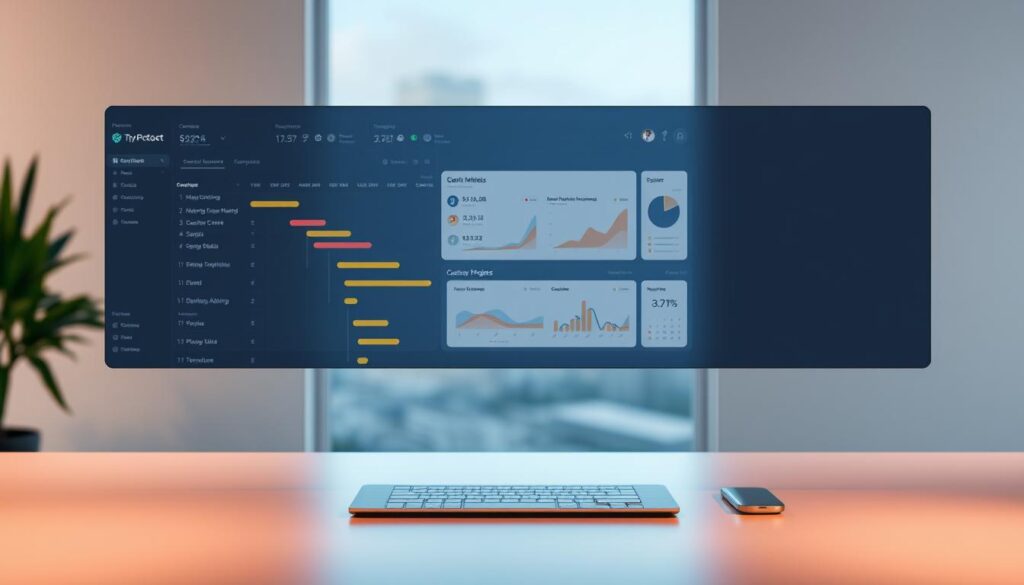In today’s fast-paced business environment, effective project management is crucial for achieving specific objectives within defined constraints. It involves applying knowledge, skills, project planning tools, and techniques to ensure successful project outcomes.
Consider a scenario where a team is tasked with launching a new product. Without a clear plan, the project can quickly go off track, leading to delays and cost overruns. However, by utilizing task management software and focusing on key tasks, teams can stay on track and achieve their goals.
As highlighted in resources on efficient project management strategies and guides on managing civil engineering projects, tackling key tasks is essential for project success.
Key Takeaways
- Effective project management is crucial for achieving project objectives.
- Utilizing task management software can enhance team productivity.
- Project planning tools help in visualizing and tracking project progress.
- Focusing on key tasks ensures that projects stay on track.
- Clear objectives and scope definition prevent scope creep.
Understanding Project Management Tasks
To understand project management tasks, it’s essential to first grasp the concept of project management itself. Project management is the disciplined approach to planning, organizing, and managing resources to achieve specific project goals.
Defining Project Management
Project management involves the application of knowledge, skills, and techniques to execute projects effectively. It encompasses various aspects, including planning, risk management, and resource allocation. A project manager oversees these aspects, ensuring that the project is completed on time, within budget, and to the required quality standards.
The role of a project manager is multifaceted, involving task delegation, team leadership, and stakeholder communication. Effective project managers utilize project management software and task tracking systems to streamline processes and enhance productivity.
Importance of Project Management Tasks
Project management tasks are crucial for the successful execution of projects. These tasks include setting objectives, creating project timelines, and allocating resources. By prioritizing tasks and managing resources effectively, project managers can ensure that projects are completed efficiently.
The use of project management tasks and tools enables teams to stay organized and focused on their goals. Moreover, effective task management helps in identifying potential risks and developing mitigation strategies, thereby reducing the likelihood of project failure.
Identifying Key Project Management Tasks

Project managers must adeptly identify and categorize tasks to ensure project success. This involves understanding the scope of the project and breaking it down into manageable tasks.
Task Categorization
Task categorization is a critical step in project management. It involves grouping tasks based on their nature or the phase of the project they belong to. Effective categorization enables project managers to allocate resources more efficiently and monitor progress.
For instance, tasks can be categorized into planning, execution, and monitoring. Within these categories, tasks can be further sub-divided. For example, under planning, tasks might include setting objectives, creating a project timeline, and identifying required resources.
“The way to get started is to quit talking and begin doing.” – Walt Disney
Utilizing task management software can significantly enhance the categorization process by providing a structured framework for organizing tasks.
| Task Category | Description | Tools/Resources |
|---|---|---|
| Planning | Setting objectives, creating timelines | Project planning tools |
| Execution | Carrying out tasks as per plan | Task management software |
| Monitoring | Tracking progress, identifying deviations | Project monitoring tools |
Prioritization Techniques
Prioritizing tasks is essential to ensure that critical tasks are completed on time. Various prioritization techniques can be employed, such as the Eisenhower Matrix, which categorizes tasks based on their urgency and importance.
Another effective technique is the MoSCoW method, which prioritizes tasks as Must-haves, Should-haves, Could-haves, and Won’t-haves. This method helps in focusing on tasks that are crucial for the project’s success.
By applying these prioritization techniques, project managers can ensure that their team is working on the most critical tasks first, thereby enhancing project efficiency and effectiveness.
Planning Your Project Effectively
A well-structured project plan is essential for navigating the complexities of project execution. Effective project planning involves several key elements that help ensure the project stays on track and meets its objectives.
Setting Objectives and Goals
Setting clear objectives and goals is the foundation of any successful project. This involves defining what the project aims to achieve and establishing measurable targets. Utilizing project management software can facilitate this process by providing tools for setting and tracking goals.
To set effective objectives, consider the following:
- Ensure goals are specific, measurable, achievable, relevant, and time-bound (SMART).
- Align objectives with the overall project vision.
- Establish key performance indicators (KPIs) to measure progress.
Creating a Project Timeline
Creating a project timeline is crucial for organizing tasks and ensuring the project is completed on time. A project timeline outlines the sequence of tasks, milestones, and deadlines, providing a clear roadmap for the project team.
Project planning tools can significantly aid in creating and managing a project timeline. These tools offer features such as Gantt charts, calendar views, and task scheduling, which help in visualizing the project schedule and making necessary adjustments.
By effectively planning your project, setting clear objectives, and creating a detailed timeline, you can enhance the likelihood of project success. Leveraging project management software and project planning tools is key to achieving this goal.
Resource Allocation in Project Management

Resource allocation is a critical component of project management that directly impacts project outcomes. Effective resource allocation ensures that the right resources are available at the right time to complete project tasks efficiently.
Identifying Required Resources
To allocate resources effectively, project managers must first identify the resources required for the project. This involves determining the types and quantities of resources needed, such as personnel, equipment, and materials. Project management software can be invaluable in this process, helping to track resource availability and utilization.
For instance, a project might require a team of developers, designers, and project managers. Identifying the specific skills and number of personnel needed is crucial. Additionally, equipment and materials necessary for the project must be listed out and their availability confirmed.
Balancing Resources and Tasks
Once the required resources are identified, the next step is to balance these resources with the tasks at hand. This involves allocating resources in a way that ensures all tasks can be completed on time and within budget. Techniques such as resource leveling and resource smoothing can be employed to achieve this balance.
For example, if a task requires a specific skill set that is in short supply, the project manager might need to adjust the project schedule or allocate additional resources to meet the demand. Project scheduling and resource optimization tips can provide further guidance on managing such challenges.
| Resource Type | Description | Allocation Method |
|---|---|---|
| Personnel | Team members with specific skills | Based on skill set and availability |
| Equipment | Machinery and technology required | Based on project needs and maintenance schedule |
| Materials | Raw materials and supplies | Based on project timeline and budget |
Effective resource allocation is essential for the successful execution of projects. By identifying required resources and balancing them with tasks, project managers can ensure that projects are completed efficiently and effectively.
Task Delegation Strategies
Delegating tasks effectively is crucial for project managers to ensure that their team is utilized optimally and project objectives are met. Task delegation involves assigning tasks to team members based on their strengths and capabilities, thereby enhancing productivity and efficiency.
Choosing the Right Team Members
Selecting the appropriate team member for a task is vital. It involves understanding the strengths, weaknesses, and workload of each team member. Effective task delegation requires a project manager to have a deep understanding of their team’s capabilities.
To choose the right team member, consider the following factors:
- Skillset and expertise
- Current workload and availability
- Past performance and experience
By considering these factors, project managers can ensure that tasks are delegated to those best equipped to handle them, thus improving the likelihood of project success.
Communicating Responsibilities Clearly
Clear communication is the cornerstone of effective task delegation. It is essential to clearly define and communicate the responsibilities and expectations associated with each task.
To communicate responsibilities clearly:
- Provide detailed task descriptions
- Set clear deadlines and milestones
- Establish a feedback mechanism
Utilizing project management software can significantly aid in this process by providing a centralized platform for task assignment, tracking, and communication.
“Delegation is not about dumping work off on others; it’s about assigning tasks that match the skills and strengths of your team members.” – Anonymous
A well-structured table can help in understanding the task delegation process better. Here’s an example:
| Task | Team Member | Deadline |
|---|---|---|
| Market Research | John Doe | 2024-09-20 |
| Content Creation | Jane Smith | 2024-09-25 |
Effective team management through task delegation not only enhances productivity but also fosters a collaborative environment where team members feel valued and motivated.
Monitoring Project Progress

To ensure successful project execution, project managers must closely monitor project progress. This involves tracking various aspects of the project to ensure they are aligned with the project plan.
Establishing Key Performance Indicators (KPIs)
Establishing Key Performance Indicators (KPIs) is a critical step in monitoring project progress. KPIs are measurable values that demonstrate how effectively an organization is achieving key business objectives. For project management, common KPIs include project schedule performance, budget performance, and quality metrics.
Project managers should identify the most relevant KPIs for their projects. For instance, a project might track:
| KPI | Description | Target |
|---|---|---|
| Schedule Performance Index (SPI) | Measures the project’s progress in terms of schedule | >1 |
| Cost Performance Index (CPI) | Measures the project’s cost efficiency | >1 |
| Defect Density | Measures the quality of the project’s deliverables | <0.5 |
For more insights on project management objectives, visit this resource.
Utilizing Project Management Software
Utilizing project management software is another essential aspect of monitoring project progress. These tools provide real-time data on project status, helping managers identify issues promptly. Popular project management software includes tools like Asana, Trello, and MS Project.
- Track task progress
- Manage resources effectively
- Generate reports on project status
By leveraging these tools, project managers can make informed decisions and keep stakeholders informed about project progress.
Risk Management in Projects
A well-planned risk management strategy is key to navigating project uncertainties. Effective risk management enables project managers to anticipate and mitigate potential issues that could impact their projects.
Identifying Potential Risks
The first step in risk management is to identify potential risks. This involves analyzing the project scope, timeline, and resources to pinpoint areas that could be vulnerable to risks. Project managers should consider various types of risks, including:
- Technical risks related to the project’s technology or infrastructure
- Financial risks associated with budget constraints or funding issues
- Operational risks that could impact the project’s day-to-day operations
- External risks, such as changes in market conditions or regulatory requirements
For more information on the project risk management process, visit Asana’s resource page on the topic.
Creating a Risk Mitigation Plan
Once potential risks have been identified, the next step is to create a risk mitigation plan. This plan outlines strategies for mitigating or managing each identified risk. Key components of a risk mitigation plan include:
- Risk assessment: Evaluating the likelihood and potential impact of each risk
- Mitigation strategies: Developing plans to mitigate or manage each risk
- Monitoring and review: Regularly reviewing the risk mitigation plan to ensure its effectiveness
Utilizing project management software can significantly enhance the risk management process by providing tools for risk tracking, mitigation planning, and team collaboration.
Communication Best Practices

Effective communication is the backbone of any successful project. It ensures that all stakeholders are informed, aligned, and working towards the same objectives.
Regular Update Meetings
Regular update meetings are crucial for keeping the project team and stakeholders informed about the project’s progress. These meetings help identify potential issues early, facilitate problem-solving, and ensure that everyone is on the same page.
- Schedule meetings at regular intervals to maintain momentum.
- Prepare a clear agenda to keep discussions focused.
- Encourage open dialogue to foster collaboration.
Utilizing Collaboration Tools
Collaboration tools are essential for facilitating communication among team members, especially in today’s remote work environment. These tools enable real-time communication, file sharing, and project tracking.
Popular Collaboration Tools:
| Tool | Description | Key Features |
|---|---|---|
| Slack | Real-time messaging platform | Channels, direct messaging, file sharing |
| Trello | Visual project management tool | Boards, lists, cards, task assignments |
| Asana | Task and project management tool | Task assignments, deadlines, workflow tracking |
By implementing these communication best practices, project managers can significantly enhance team collaboration, reduce misunderstandings, and improve overall project outcomes.
Quality Control Measures
Project managers must prioritize quality control to ensure their projects meet the required standards. Effective quality control measures are crucial for maintaining project integrity and achieving project goals.
Establishing Clear Standards
Setting quality standards is the foundation of any quality control process. These standards should be clearly defined, measurable, and aligned with project objectives. By establishing these standards, project managers can ensure that all team members are working towards the same quality goals.
To set effective quality standards, project managers should consider industry best practices, regulatory requirements, and stakeholder expectations. This involves a thorough analysis of the project’s scope, timeline, and resources to determine the quality benchmarks.
Conducting Regular Reviews
Quality assurance reviews are essential for ensuring that project deliverables meet the established quality standards. These reviews involve systematic evaluations of project processes and outputs to identify areas for improvement.
Project managers can utilize project management software to facilitate quality assurance reviews. These tools enable real-time monitoring, reporting, and collaboration, making it easier to track quality metrics and address any issues promptly.
By conducting regular quality assurance reviews, project managers can proactively identify and mitigate quality risks, ensuring that project outcomes meet the required standards.
Managing Stakeholder Expectations

Managing stakeholder expectations is a key aspect of project management. It involves understanding the needs and expectations of various stakeholders and ensuring that these are met throughout the project lifecycle.
Identifying Stakeholders
The first step in managing stakeholder expectations is to identify who the stakeholders are. This includes project team members, clients, end-users, and anyone else who has a vested interest in the project’s outcome. Effective stakeholder identification is crucial for understanding their needs and expectations.
To identify stakeholders, project managers can use various techniques such as stakeholder mapping and analysis. This involves assessing the level of influence and interest each stakeholder has in the project. By doing so, project managers can prioritize their efforts and focus on the stakeholders who are most critical to the project’s success.
Regular Communication and Feedback
Once stakeholders are identified, regular communication becomes essential. This involves keeping stakeholders informed about project progress, timelines, and any changes that may affect them. Project management software can be a valuable tool in facilitating this communication by providing a centralized platform for updates and feedback.
Regular feedback is also crucial in managing stakeholder expectations. By soliciting feedback, project managers can understand if there are any concerns or issues that need to be addressed. This not only helps in managing expectations but also in building trust with stakeholders.
Effective communication strategies include regular update meetings, email updates, and the use of collaboration tools. By maintaining open lines of communication, project managers can ensure that stakeholders are always informed and that their expectations are being met.
Budget Management in Project Management
Project managers must prioritize budget management to ensure project objectives are met within financial constraints. Effective budget management involves several key tasks that help in delivering a project successfully.
Creating a Project Budget
Creating a project budget is the first step in budget management. It involves estimating the total cost of the project, including resources, materials, and labor. To create an accurate budget, project managers should:
- Identify all the tasks and activities required to complete the project.
- Estimate the cost of each task, considering resources and materials needed.
- Establish a contingency fund to cover unexpected expenses.
Utilizing project budget management tools and techniques can significantly enhance the accuracy of budget creation.
Tracking Expenses and Adjustments
Once the budget is created, tracking expenses becomes crucial to stay within budget. Project managers should regularly monitor actual expenses against the budget to identify any variances.
Key steps in tracking expenses include:
- Regularly updating the budget with actual expenses.
- Analyzing variances to understand their causes.
- Making adjustments to the budget or project plan as necessary to stay on track.
Using project management software can streamline the process of tracking expenses and making adjustments. It provides real-time data, enabling project managers to make informed decisions.
Effective expense tracking and budget management are critical for the successful execution of a project. By creating a comprehensive budget and continuously monitoring expenses, project managers can ensure that their projects are completed on time and within budget.
Closing a Project Successfully

Project closure is a critical phase that demands thoroughness and precision. It involves a series of steps that ensure the project is completed effectively and that lessons learned are documented for future projects.
Completing Final Tasks
Completing final tasks is an essential part of project closure. This includes:
- Ensuring all deliverables are met and accepted by the stakeholders.
- Documenting the project’s outcomes and comparing them against the initial objectives.
- Formally closing contracts with vendors and service providers.
Utilizing project management software can significantly streamline this process by keeping track of tasks and deadlines. For more insights on wrapping up a project effectively, visit Park University’s blog on project management.
Conducting Post-Project Reviews
Conducting post-project reviews is crucial for understanding what went well and what didn’t. This involves:
- Gathering the project team to discuss successes and challenges.
- Documenting the lessons learned and best practices.
- Identifying areas for improvement in future projects.
As noted by project management experts, “A post-project review is not just about evaluating the project’s success but also about learning from the experience to improve future projects.” This reflective practice is essential for continuous improvement in project management.
By following these steps and utilizing the right tools, project managers can ensure that their projects are closed successfully, setting the stage for future successes.
Continuous Improvement in Project Management
In the dynamic landscape of project management, continuous improvement stands as a critical factor for success. Project managers must continually assess and refine their strategies to ensure projects are completed efficiently and effectively.
Continuous improvement involves a systematic approach to learning from past projects and implementing changes to enhance future project outcomes. By adopting this mindset, project managers can foster a culture of excellence within their teams.
Learning from Past Projects
One of the key aspects of continuous improvement is the ability to learn from past projects. This involves conducting thorough post-project reviews to identify successes, challenges, and areas for improvement.
By analyzing these insights, project managers can develop strategies for improvement and implement changes that will positively impact future projects.
| Aspect | Past Projects | Future Improvements |
|---|---|---|
| Project Planning | Identified delays in project initiation | Implement more detailed project timelines |
| Team Collaboration | Noted communication gaps among team members | Utilize collaboration tools to enhance team interaction |
| Risk Management | Encountered unforeseen risks | Develop more comprehensive risk mitigation plans |
Implementing Best Practices
Implementing best practices is another crucial element of continuous improvement. This involves staying updated with the latest methodologies and technologies in project management, such as project management software, to streamline processes and enhance productivity.
By integrating these best practices into their workflows, project managers can ensure that their projects are executed with the highest level of efficiency and effectiveness.
The Role of Technology in Project Management

Technology has revolutionized the way projects are managed, enhancing efficiency and productivity. In today’s fast-paced business environment, leveraging the right technology is crucial for successful project management.
Tools for Project Management Efficiency
Various tools and software are available to enhance project management efficiency. Project management software like Asana, Trello, and Microsoft Project helps in planning, organizing, and controlling projects. These tools facilitate task assignment, progress tracking, and team collaboration, ensuring that projects are completed on time and within budget.
The use of such tools also enables better resource allocation and risk management. For instance, Gantt charts and Kanban boards provide visual representations of project timelines and workflows, helping teams to identify potential bottlenecks and areas for improvement.
Benefits of Automation
Automation is another significant aspect of technology in project management. By automating repetitive and mundane tasks, teams can focus on more strategic and value-added activities. Automation tools can help in streamlining workflows, reducing manual errors, and increasing overall productivity.
The benefits of automation in project management include improved accuracy, enhanced compliance with regulatory requirements, and faster project delivery. Moreover, automation enables real-time monitoring and reporting, allowing project managers to make informed decisions promptly.
By embracing project management technology and automation, organizations can achieve greater efficiency, reduce costs, and improve project outcomes. As technology continues to evolve, it is essential for project managers to stay abreast of the latest trends and tools to remain competitive.
Trends in Project Management
As the workplace continues to evolve, project managers must stay abreast of the latest trends and methodologies. The shift towards more flexible and adaptive approaches is transforming how projects are managed and executed.
Adapting to Remote Project Management
The rise of remote work has significantly impacted project management. With teams spread across different locations, effective communication and collaboration tools are more crucial than ever. Project managers must adapt to remote project management by leveraging technology to facilitate seamless communication and maintain team cohesion.
Some key strategies for successful remote project management include:
- Utilizing video conferencing tools for regular meetings
- Implementing project management software for task tracking and collaboration
- Establishing clear communication protocols
Emerging Methodologies and Frameworks
Project management is witnessing the emergence of new methodologies and frameworks designed to enhance flexibility and efficiency. Agile methodologies, for instance, continue to gain popularity for their iterative approach to project management, allowing for greater adaptability in response to changing project requirements.
Other emerging trends include:
| Trend | Description | Benefits |
|---|---|---|
| Hybrid Methodologies | Combining elements of different methodologies | Flexibility, Adaptability |
| AI in Project Management | Using AI for predictive analytics and task automation | Enhanced Efficiency, Data-Driven Decisions |
For more insights on the stages of engineering project management, visit https://worldcivilsociety.com/stages-of-engineering-project-management/.
Conclusion: Enhancing Project Success Through Effective Task Management
Effective task management is critical to project success. By understanding and implementing key project management tasks, teams can ensure their projects are completed on time, within budget, and to the required quality standards.
Utilizing project management software can significantly enhance task management by streamlining processes, improving communication, and increasing productivity. Tools like these enable teams to stay organized and focused on project goals.
The integration of task management best practices, along with the right technology, such as project management software, can drive project success. By adopting these strategies, teams can improve their overall project management capabilities, leading to more successful outcomes.
Ultimately, the key to project success lies in the ability to manage tasks effectively, allocate resources efficiently, and maintain clear communication throughout the project lifecycle.
